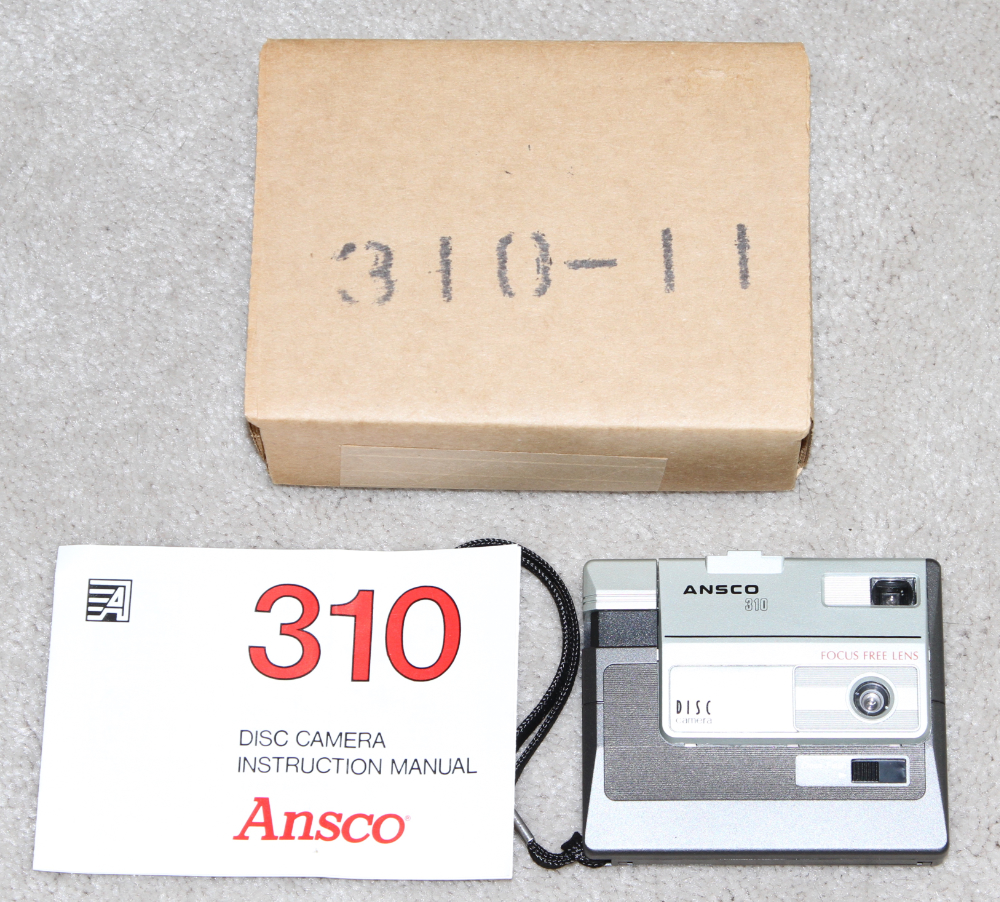
1986 R

![]()
ANSCO 310 DISC CAMERA - 1986.
Kodak began marketing disc cameras in 1982 and other manufacturers soon
followed suit. Discs held 15 pieces of film and each piece of
film was very tiny, about 8 x 10 mm in size. Prints very usually
of very poor quality due to the small size of the negatives.
Manufacturer of the film was completely discontinued in December of
1999. See 1983 for other disc cameras and disc film.
https://en.wikipedia.org/wiki/Disc_film
http://www.subclub.org/shop/ansco2.htm
https://camerapedia.fandom.com/wiki/Ansco
https://www.youtube.com/watch?v=6OtETWOGr4E
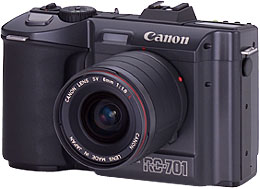

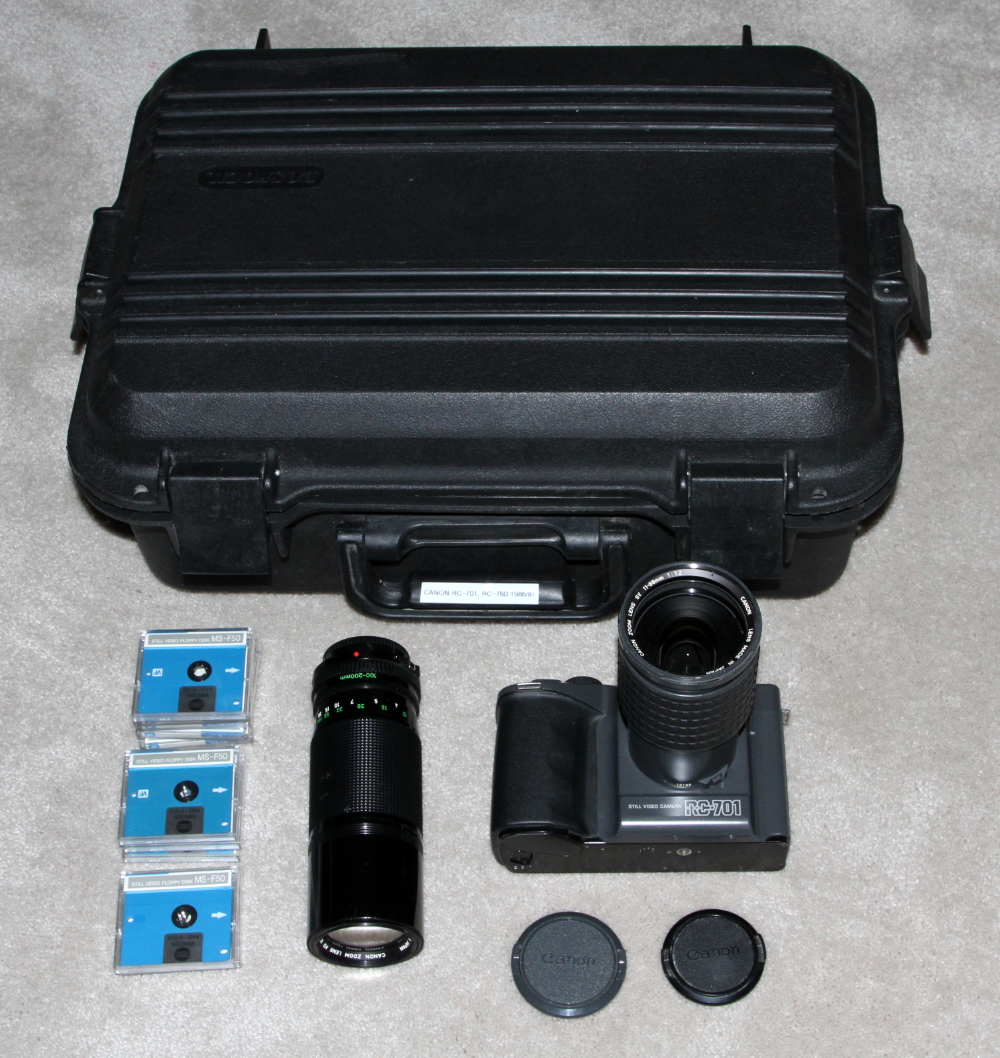
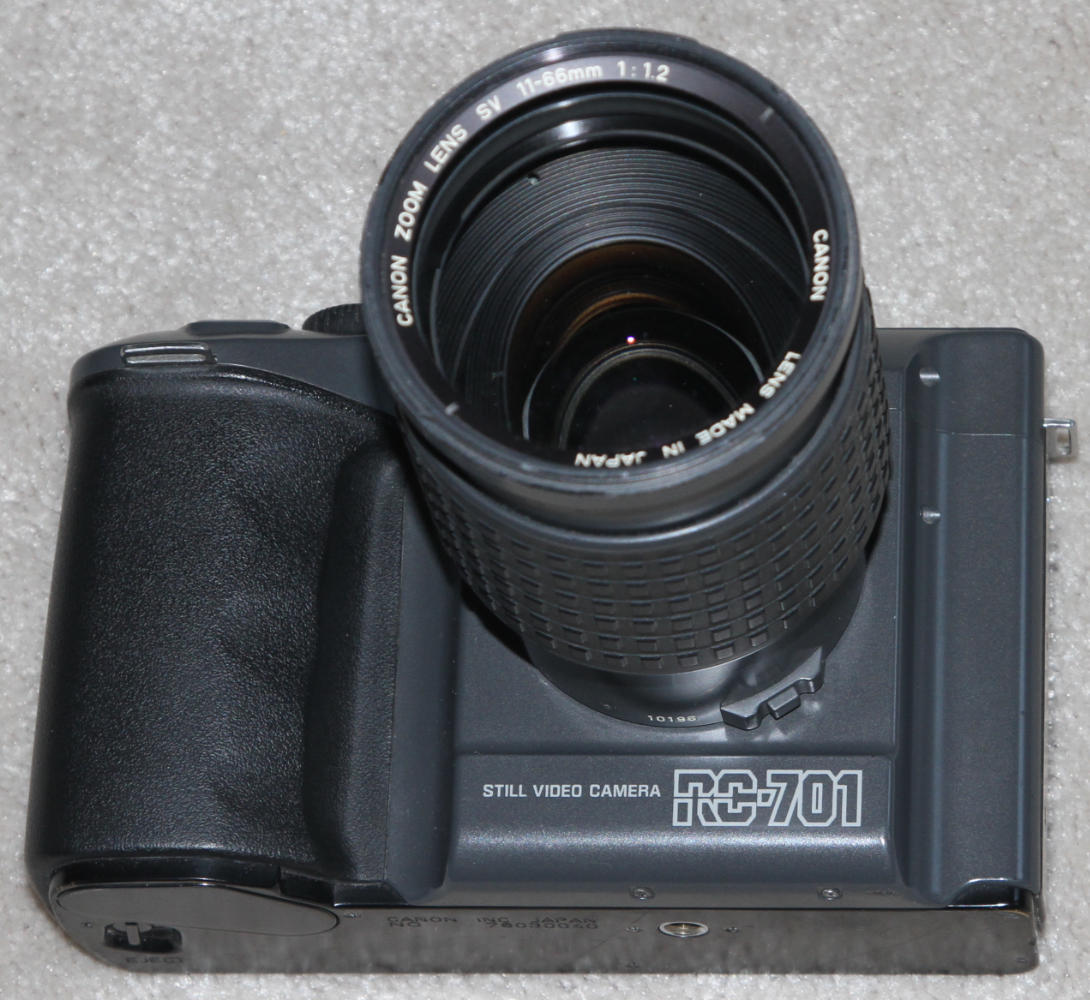
![]()
CANON RC-701 STILL VIDEO CAMERA - 1986. Canon was the first to market a still video camera, the professional model RC-701 (one source states that the 1981 Sony Mavica was marketed, but this has not been independently verified as of yet). The RC-701 was aimed mainly at the press market. It had four dedicated interchangeable lenses and also offered an adapter for 35mm lenses. Price of the RC (RC stood for Realtime Camera) with an 11-66mm f/1.2 lens was about $3,000. The complete RC-701 system consisting of the camera, a player/recorder, a printer, a laminator, and a unit for phone transmission cost about $27,000. The CCD was 6.6mm x 8.8mm with 780 pixels horizontally. This was equal to about 300 horizontal and 320 vertical lines on a TV monitor. The RC-701 had a swing-up mirror similar to a conventional SLR and had shutter speeds of 1/8 to 1/2000 second. It could capture 1, 2, 5, or 10 frames per second. Additional lenses included a 6mm f/1.6, comparable to a 24mm wide angle 35-mm lens, and a 50-150mm telephoto zoom. Both lenses were for the RC-701 only and could not be used on other cameras. Popular Photography, July 1986, p62. We believe we were the first digital camera history web site to provide a photo and information concerning this camera. Copy and paste first URL below for English translation of statement by Yoshiyuki Takishima (former director of Canon).
https://dc.watch.impress.co.jp/docs/column/165/1221882.html
http://global.canon/en/c-museum/product/svc443.html
https://www.pacificrimcamera.com/rl/00400/00400.pdf
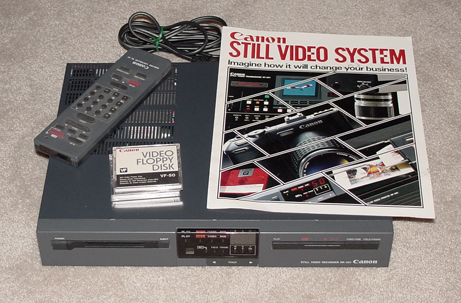

![]()
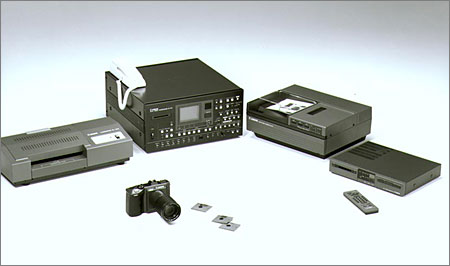
CANON RR-551 STILL VIDEO PLAYER - 1986
CANON STILL VIDEO SYSTEM WITH RC-701 CAMERA
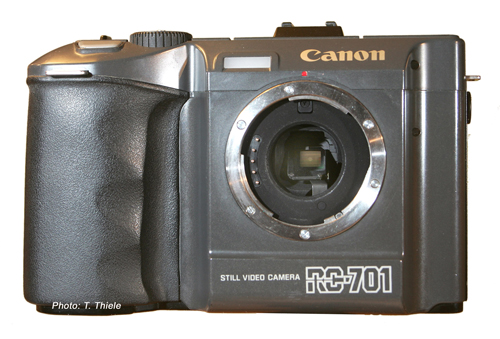

CANON RC-701 Mirror System - Magazine
aticles of the time stated that the RC-701 had a flip-up mirror similar
to standard DSLR film cameras, but as shown by the photos above
submitted by Tom Thiele of Germany, the RC-701 had an unusal mirror
mechanism. Instead of flipping up, it moved downward and to the right
as seen from the front. If you are fortunate enough to own a RC-701,
check out this unusal mirror movement for yourself. Errors in reporting
such as this by professional photography magazines make you wonder how
much other misinformation is now permanently part of recorded history.
Thanks to Tom Thiele for setting the record straight on this
matter. We believe we were the first digital camera history web
site to provide a photo and information concerning this camera.
CANON RR-551 STILL VIDEO PLAYER/RECORDER - 1986. The player/recorder in the complete Canon system mentioned above was the RR-551, the world's first still video player/recorder to be marketed. The RR-551 shown above, in excellent condition, was purchased on eBay with manual, remote, floppies and several manufacturer's brochures for $25.
https://www.pacificrimcamera.com/rl/00400/00400.pdf
https://books.google.com/books?id=zuMDAAAAMBAJ&pg=PA56&lpg=PA56&dq=canon+%2B+%22RR-551%22&source=bl&ots=lrtxM0anJA&sig=yyyw2DcxxE7icAJTLghUybb4KIQ&hl=en&sa=X&ved=0CC0Q6AEwBWoVChMI3uny8oGfyAIVRj4-Ch0OkgCq#v=onepage&q=
canon%20%2B%20%22RR-551%22&f=false
CHINON STILL VIDEO CAMERAS - 1986.
At Photokina, Chinon, Fuji, Konica and Nikon all showed mock-up
versions of SLR still-video cameras. Chinon's black box appeared
without specs, but Fuji's has a zoom lens with macro mode, a built-in
meter and a range of shutter speeds approximating those of standard
35-millimeter cameras. Chinon also showed a still video back for
their CP-9AF camera as Well as a working still video camera.
Electronic Photography, John J. Larish,
1990, p20 and p33. The Chinon model shown as a mock-up was
apparent;y a ruse by Chinon covering up the actial still video camera
they had already developed (similar to the Kodak ruse of Photokina 1990
involving a still video camera although Kodak already had a working
DCS-100 digital camera.)
https://www.nytimes.com/1986/10/05/arts/camera-at-photokina-still-video-cameras.html
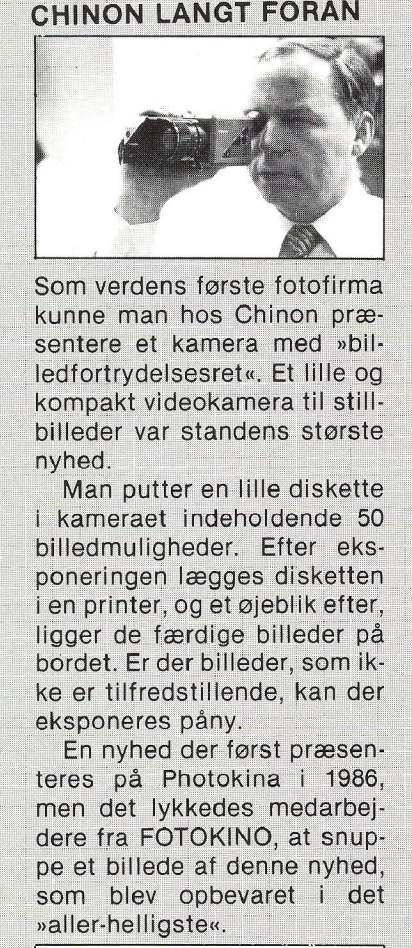
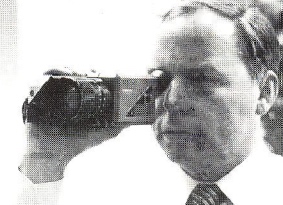
At Photokina in 1986 Chinon demonstrated what was most
certainly a still video camera that was reported by Danish media, but
by no one else (Except John Larish in his 1990 book). While the photo world was abuzz with news about
the Canon RC-701, Sony MVC-a7AF and other still video cameras, the
unnamed Chinon still video camera described in the Danish media remains
a mystery to this day. As Ralf Jannke noted in his article posted
on our front page highlighting the many significant, but unheralded,
contributions by Chinon to early digital photography, others often
received credit for advancements actually made by Chinon. NOT MARKETED.
The description provided by Danish media with the above photo reads as follows:
"CHINON FAR AHEAD. As the world's first photo company, Chinon was able
to present a camera with an image cancellation right (ability to delete
photos?). A small and compact video camera for still images was
the biggest news item on the stand (biggest news at Photokina
1986?). You put a small diskette in the camera containing 50
image options (able to store 50 images?). After the exposure, the
diskette is put in a printer, and a moment later, the finished images
are on the table. If there are images that are not satisfactory, they
can be exposed again. A novelty that was first presented at
Photokina in 1986, but employees from FOTOKINO managed to grab a
picture of this novelty, which was kept in the most holy place
(secret file?)."
Translation by Ralf Jannke of https://www.digicammuseum.de/
In his 1990 book, Electronic Photography, John Larish says the Chinon had a zoom lens with multi-beam autofocus. Page 20.
"Here Chinon impressed with both a SLR with spot metering, and a floppy disk camera. It was tried years ago, but Chinon's camera can hold up to 50 shots on a floppy disk, while the price of the camera is expected to be in the same price range as an average SLR with zoom."
Translation above by Leif Johansen.
We will continue to pursue this intriguing topic and report any new info when found.
https://kamerasamling.dk/annoncer/fotokino%20alt%20om%20foto/1984/photokina%20omtale%201984%2011%2012.pdf
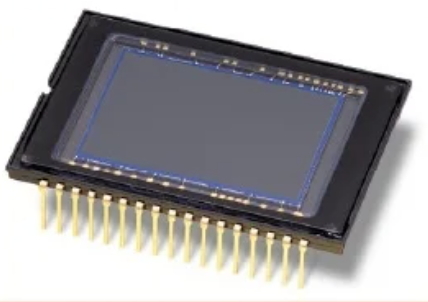
1.4MP
CCD - 1986. Kodak develops a 1.4
million
pixel CCD. Modern Photography, September 1986, p28.
https://en.wikipedia.org/wiki/Kodak_DCS
https://aehistory.wordpress.com/1986/10/09/1986-kodak-invents-the-megapixel-sensor/
CCD Construction
- Charge-coupled devices (CCDs) are silicon-based integrated circuits
consisting of a dense matrix of photodiodes that operate by converting
light energy in the form of photons into an electronic charge.
Electrons generated by the interaction of photons with silicon atoms
are stored in a potential well and can subsequently be transferred
across the chip through registers and output to an amplifier. The
schematic diagram illustrated in the left image shows various
components that comprise the anatomy of a typical CCD.
https://micro.magnet.fsu.edu/primer/java/digitalimaging/ccd/virtual2/index.html


FIRST COMMERCIAL DIGITAL CAMERA - 1986. MegaVision
introduced a high-resolution 2000-line tube camera system called the
Tessera, the very first digital camera to be used in commercial
photographic applications. See Meagavision Tessera on our 1989 page.
https://www.digitalkameramuseum.de/en/cameras/item/megavision-tessera
https://techprate.com/digital/who-invented-the-first-digital-camera/
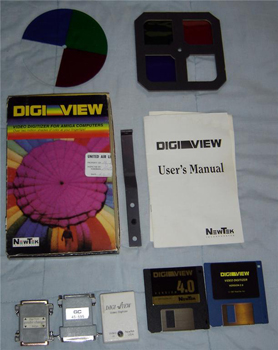
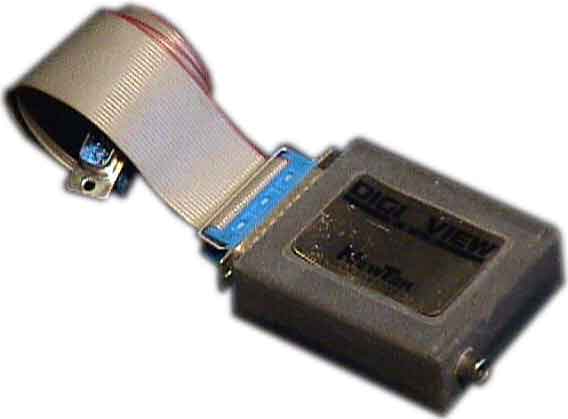

![]()
NEWTEK Digi-View - 1986, 1987, 1989. In
1986 the NewTek Digi-View, built to run on the Amiga platform, was the
first inexpensive video digitizer designed for home computers.
It was developed to take advantage of the Amiga 1000's advanced video capabilities.
Digi-View was also the first personal computer digitizer to capture
4096-color,
photo quality images. Soon afterward, NewTek followed
with DigiPaint, which provided video painting capabilities within the
computer
system. It was developed to take advantage of the Amiga 1000's
advanced video
capabilities and was plugged into the Amiga's parallel printer port. A
video cable
then lead from the digitizer to either a B&W video camera with a
color
wheel attached, or to an external color splitter box. The DigiView took
3
passes to digitize a frame, and each pass was done by filtering through
one of
3 primary colors: red, green, and blue. This meant that the image being
digitized had be still or paused. The digitizer generally captured at
320x200
pixels with up to 4096 colors, but was capable of 640x200 pixels if the
system
had sufficient memory. Once all three captures were done, the
Newtek software
then merged them into a single color capture. Thanks to Patrick
Murphy for providing information
concering the Digi-View.
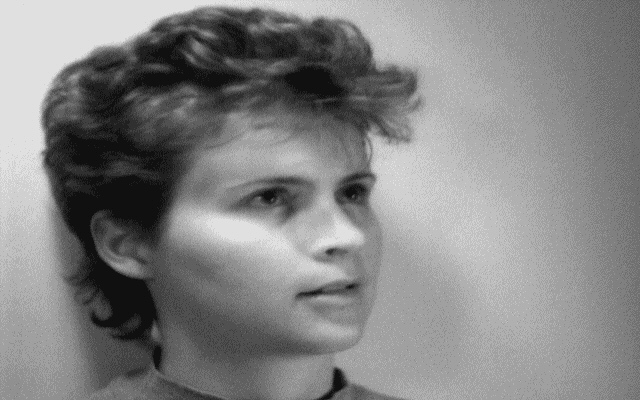

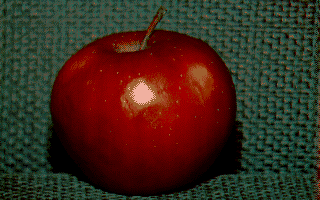
Examples
of photos captured with the Newtek Digi-View and the Digi-View
digitizer .
http://time.com/26380/tims-vermeer/
https://www.flickr.com/photos/53568131@N00/6433617601
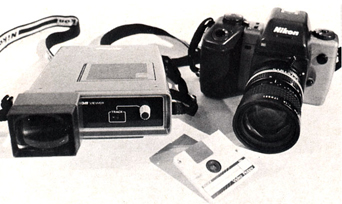

NIKON
SVC 1-A (Still Video Camera) PROTOTYPE - 1986.
This camera was built around a 2/3-inch CCD of 300 000 pixels. It
allowed the analog recording of 25 or 50 images on a small floppy disk
of two inches, the same one as used by the Canon Ion to be marketed in
1988. The body of the SVC was designed similar to that of the
Nikon F801 film camera which was marketed two years later, Two
lenses were intended for the SVC, a 6mm f/1.6 and a 10 to 40mm
f/1.4. The Nikon SVC was shown at Photokina '85, but the
electronics were mainly by panasonic. NOT MARKETED.
https://www.digitalkameramuseum.de/en/esvc/item/nikon-svc-1986
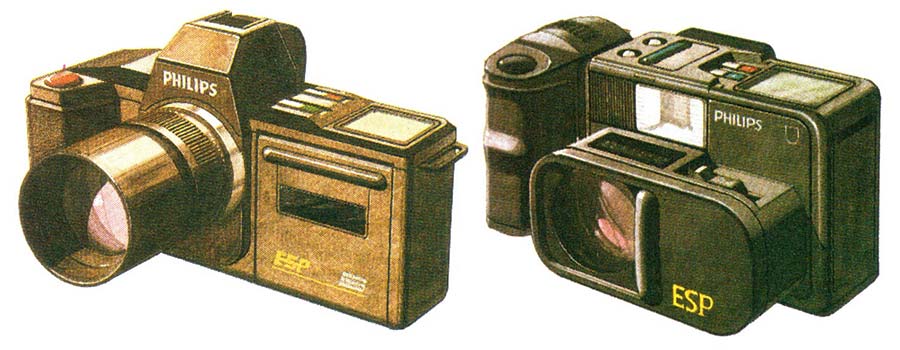
PHILIPS STILL VIDEO CAMERA CONCEPT - 1986/87. Drawings (see above) and wooden models were made, but no prototype was built. Philips was one of those companies that were slow to respond in this market and did not have a consumer camera ready until 1997. Back in 1986 and 87, Philips was involved in a concept study that included some drawings and wooden mockups. " Philips mentioned a "homemade" DTC sensor of 1/2", of only 180,000 pixels, allowing a resolution of around 300 TV lines, a bit like the Konica SV-20 presented the previous year." Philips wanted to arrive at a price of $1000 for one or the other of these devices. Finally coming to market eleven years after the initial Sony and Canon still video cameras cameras, they were far behind the power curve from which they never did fully recover. NOT MARKETED.
https://www.digitalkameramuseum.de/en/prototypes-rarities/item/philips-esp-study
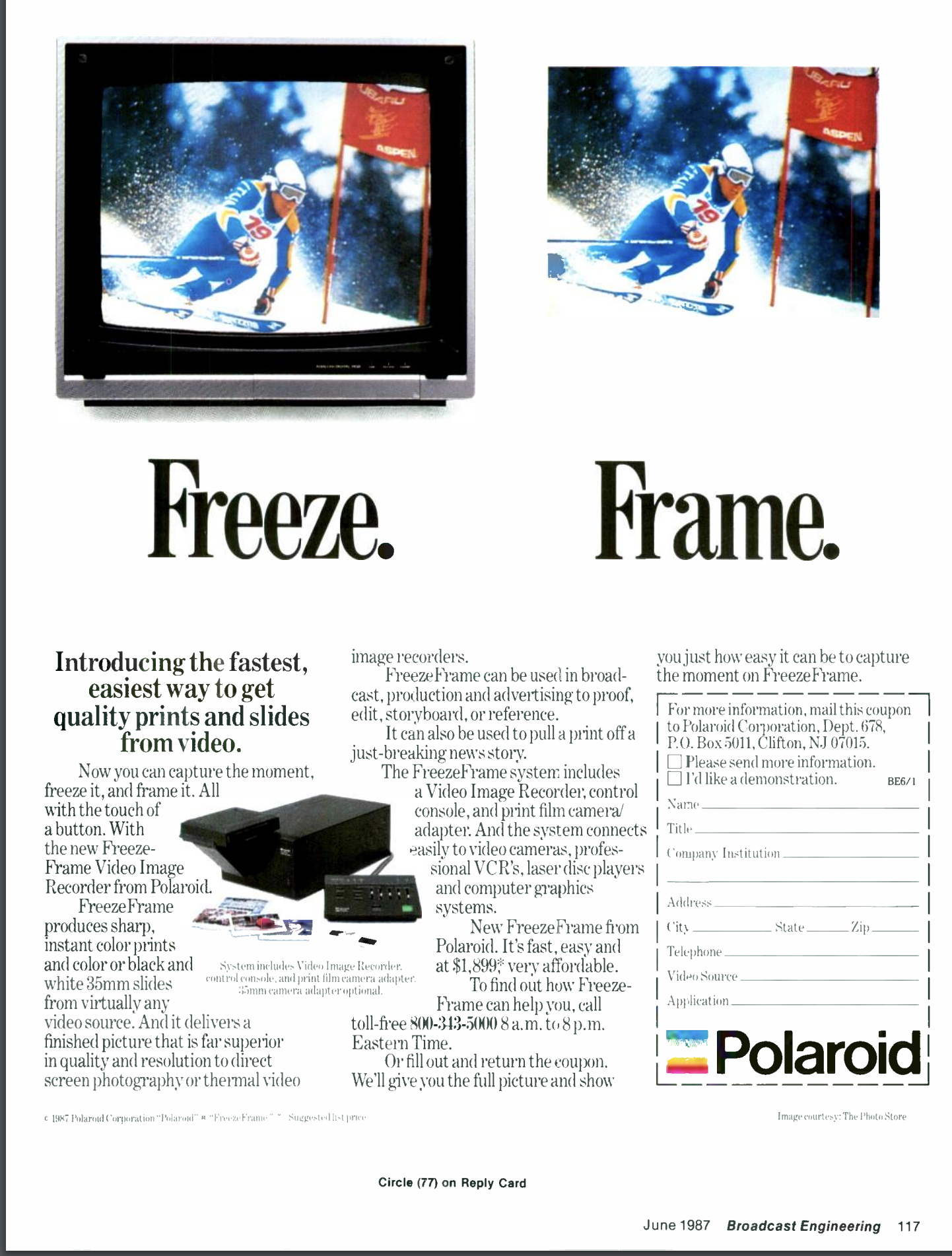
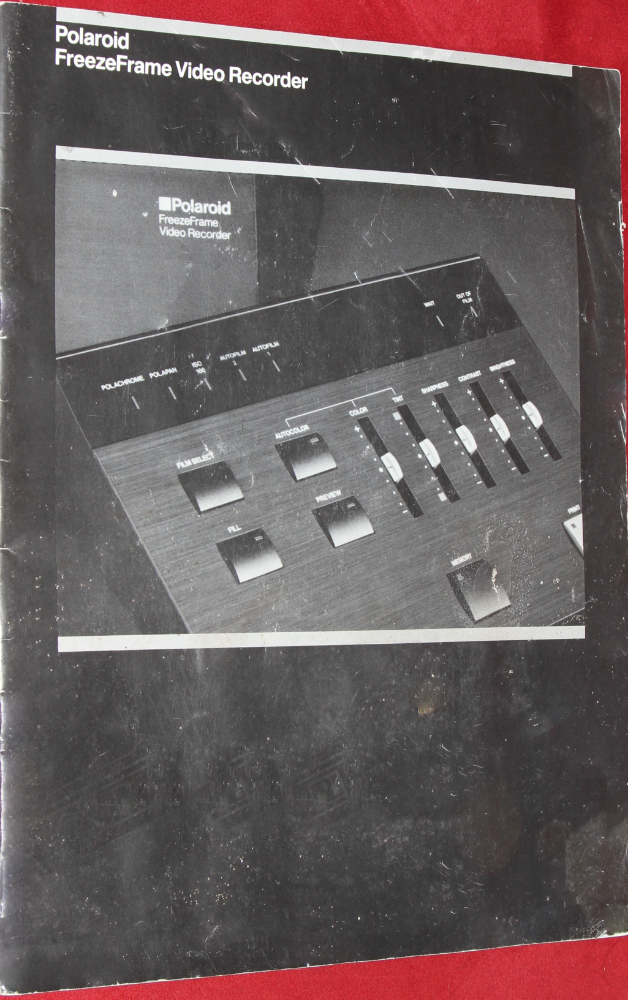
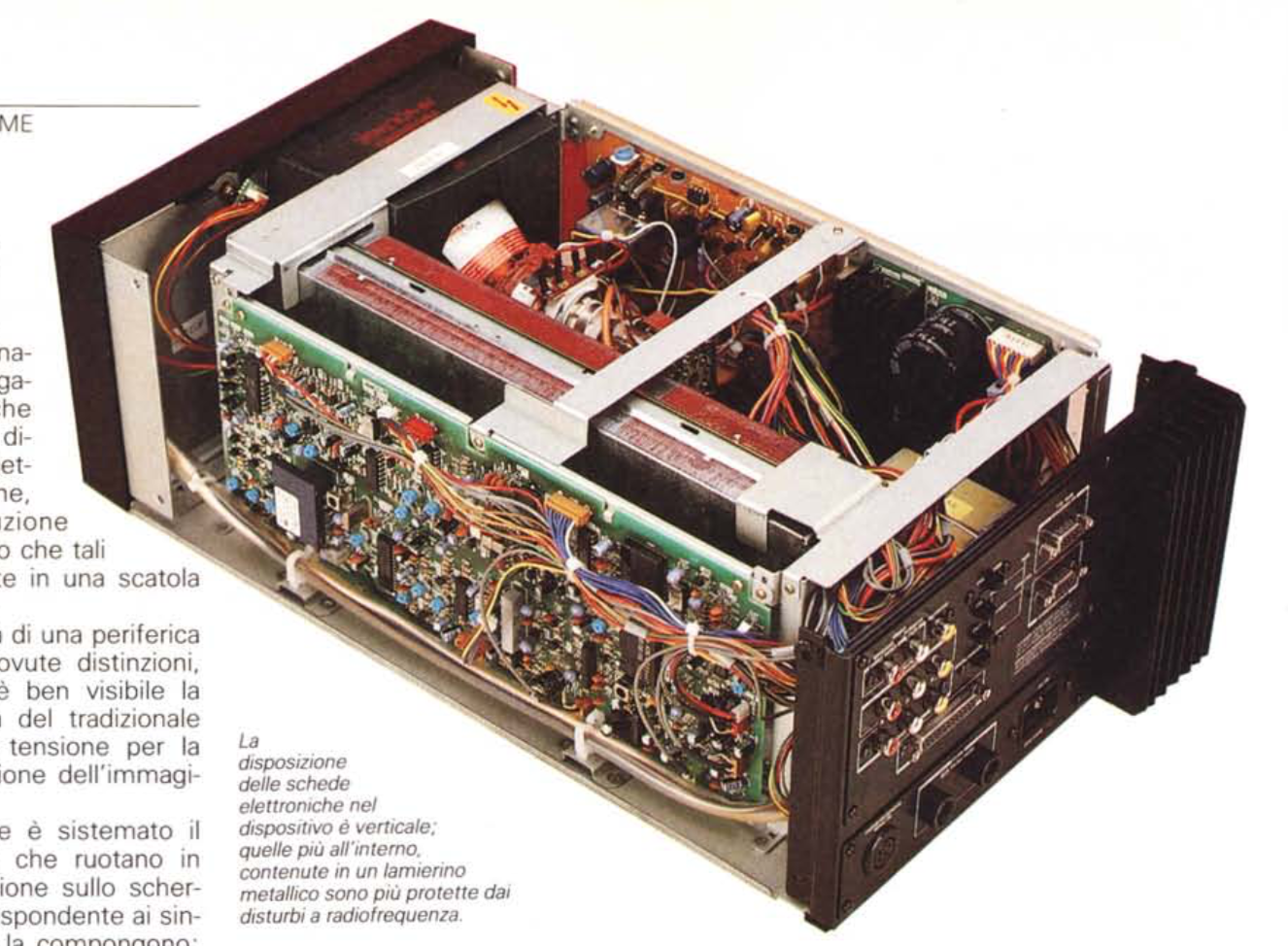

![]()
Polaroid FreezeFrame Video Recorder (FFVR-2) - 1986.
Marketed in 1987. The FreezeFrame Video Recorder was developed
jointly by Polaroid and Toshiba. The purpose was to provided color or
black and white prints from video input. Prints could be on 35mm
film or on Polaroid print paper. A Poloroid camera or a special
35mm camera supplied by Polaroid could be attached to the rear of the
video recorder. A CRT (cathode ray tube) with Color wheel for
color photos supplied the still image which was to be
photographed. Time required to record an image depended on the
film type, with color slide film requiring up to 50 seconds. You
would have been very serious about obtaining prints from video to
purchase this device. In addition to costing $1,899 ($5,570 in
2025), it weiged about thirty pound and was almost two feet in
length with attachments connected. MSRP $1,899. (Rare on U.S. eBay).
https://filmphotograph.com/polaroid/about
http://www.digitanto.it/mc-online/PDF/Articoli/099_130_135_0.pdf
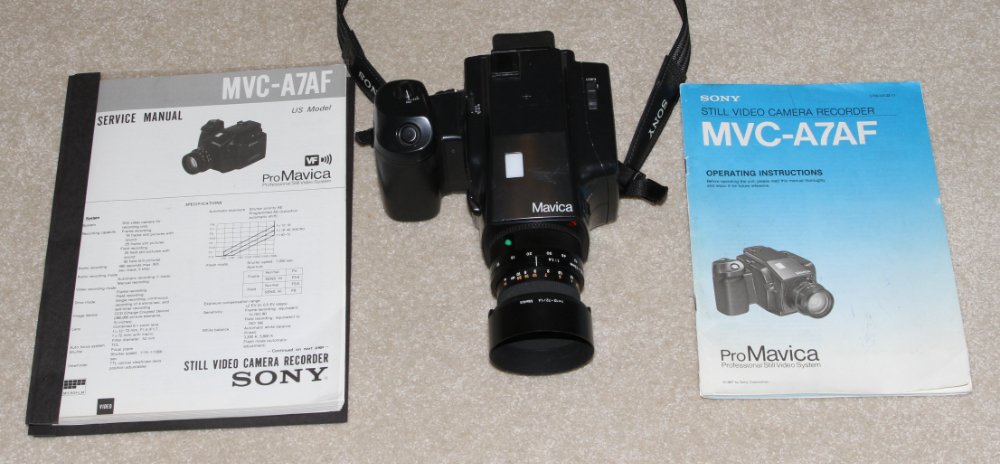

![]()
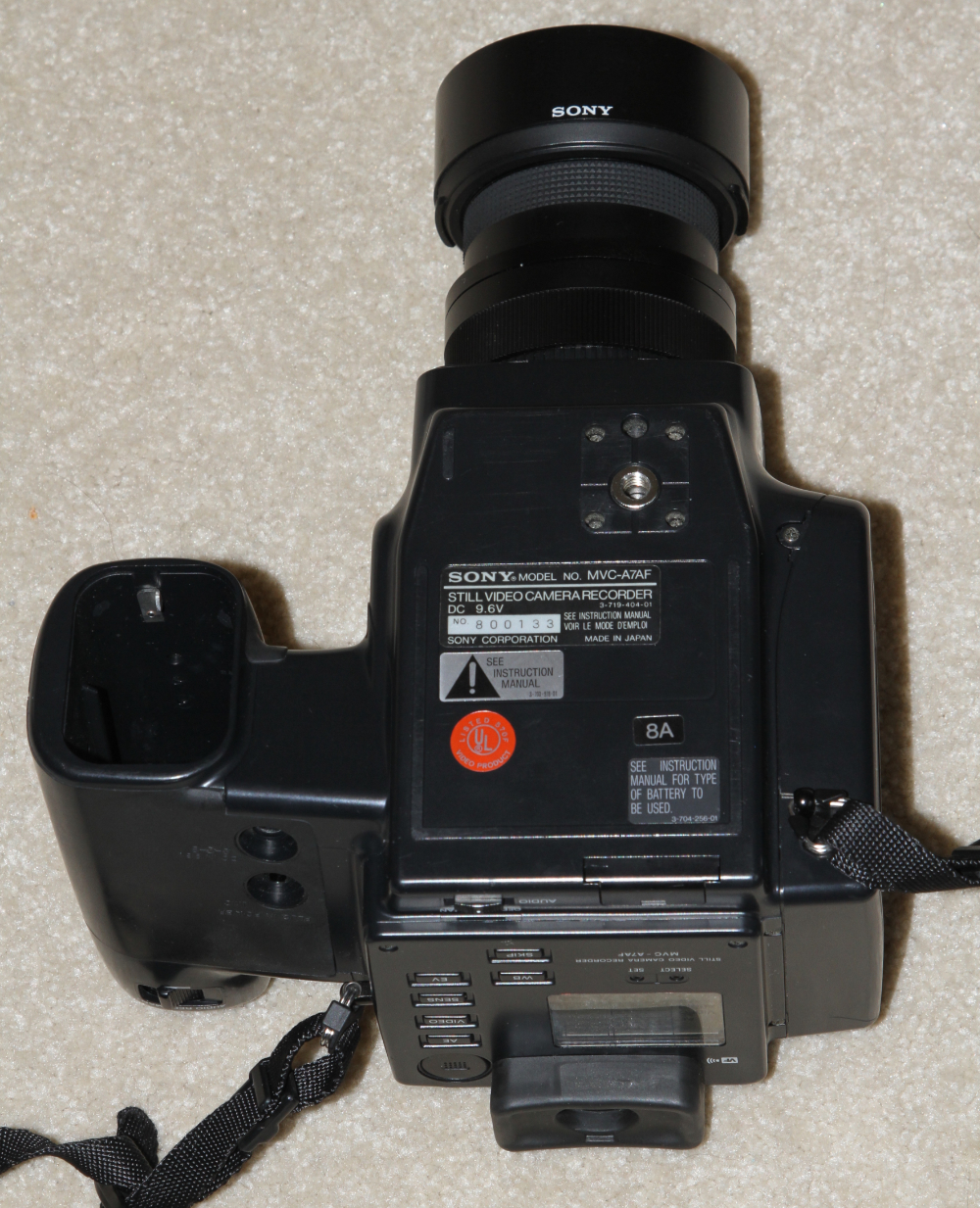
SONY
MAVICA MVC-A7AF - 1986. The A7AF was
a still video camera which recorded images onto two-inch floppy disks
(MP-50) and the first to provide audio annotation.
One disk could hold up to 50 images in Field mode or 25 images in Frame
mode. The Field mode recorded on a single track of the disk while
the Frame mode required two tracks, but provided better quality
images.
While recording in Field mode ISO rating was 160, and 80 for Frame
mode.
The A7AF could also record 9.6 seconds of audio to accompany each image
by use of an additional recording track. Images were registered
by
a 2/3-inch charge coupled device (CCD) of 380,000 pixels. The
lens
was a 6X zoom, 12-72mm, f/1.4-1.7, with macro capability. The
lens
could be focused manually or automatically and had a focal plane
shutter
with speeds of 1/15 to 1/1000 second. The viewfinder was
TTL
(through-the-lens) with an adjustment for individual eyesight.
The
A7AF specifications included auto white balance, EV adjustment of + or
-2 in 0.5 EV steps, shutter priority and AE modes, self-timer, remote
control
option (RM-S7), date indicator, and shoe for an optional flash
(MFL-30).
Other options included an NP-4000 battery pack which could record
approximately
50 disks per charge, a DCC-2600A car battery cord, an MVR-A770 still
video
recorder/player, and a variety of optional microphones to supplement
the
built-in microphone. Normal operation was by six L40 (LR6)
alkaline
batteries and a button lithium battery (CR2025). Supplied
accessories
were an eyepiece cover, lens hood, shoulder strap, and the CR2025
button
lithium battery. Unusual features of the A7AF included a
recording
head contamination indicator and a moisture condensation indicator. The
A7AF was for recording only and playback required use of the Sony
MVR-A770
still video recorder/player shown below. Information concerning the A7AF is
from
an operating manual kindly provided by Mr. Charley Mack of Park West,
Chicago.
Also see Understanding Electronic Photography, John J. Larish,
1990,
p19 and Digital Photography,
Mikkel Aaland, 1992,
p15. (Very Rare on U.S. eBay)
https://goodoldbits.wordpress.com/2016/01/22/mavica-1-analog/.
https://www.digitalkameramuseum.de/en/esvc/item/sony-mvc-a7af
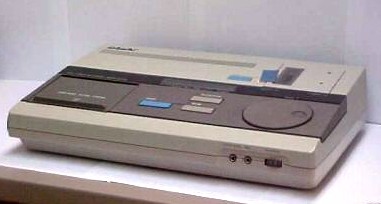
![]()
Sony MVR-A770 still video recorder/player, Popular Science, November 1987, page 55.
https://en.wikipedia.org/wiki/Sony_Mavica

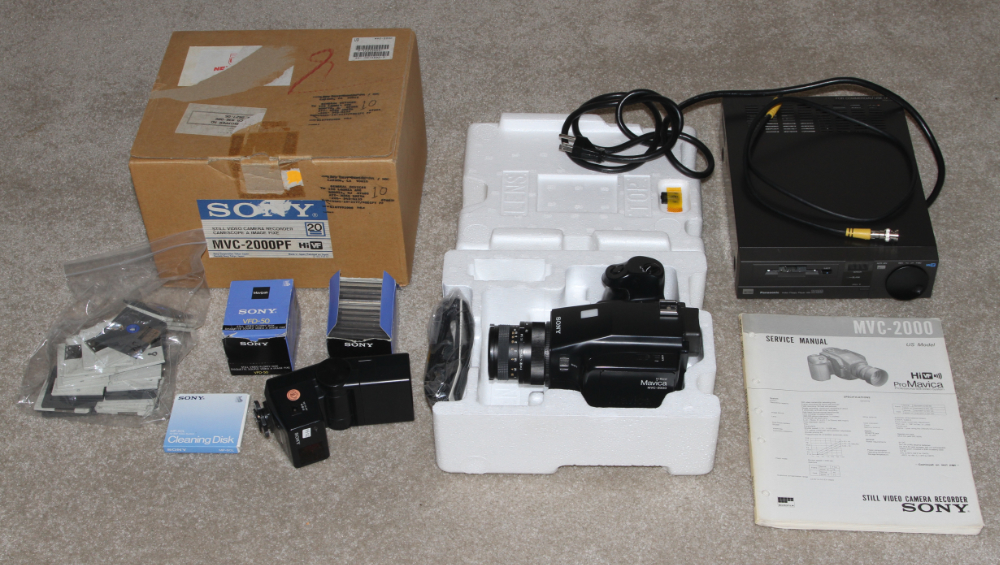
![]()
SONY ProMavica
MVC-2000, 2000PF, 2010 - 1986/89/90.
The MVC-2000PF was a pre-production, hand-built camera sent to specific
photographers for testing. The production model went on sale in
1989. This analog still video camera had a 13X zoom lens and was
available only in NTSC. It was a one-CCD camera of 2/3-inch and
380K pixels. 48mm to 288mm f/1.4 zoom lens. Shutter 1/15 to
1/1000. MSRP in 1989 of $3,395. Collection includes the
Sony MFL-30 flash made for the MVC-2000 and a Panasonic AGS-100 still
video player (very rare), numerous Sony mini floppy disks and the
service manual which includes the operating manual.
The
MVC-2000PF pre-production proofing version of the MVC-2000 is thus
extremely rare. In the past, Sony often hand-built prototypes
of upcoming cameras and distributed them to a few individuals for
testing prior to commencing full production. Those prototypes had the
PF designation added to the normal model number. Cameras such as
the Nikon QV-1000C which were produced in very small numbers (about 180
units for the QV-1000C) sell for astronomical prices among collectors
due to their rarity, however, even 180 units could be considered mass
production compared to the small number of hand-built prototypes such
as
the MVC-2000PF. (Very Rare on U.S. eBay)

This
was one of our luckiest purchases ever. Another potential
bidder (see above email) who was aware of the rarity of the PF version, but
was out of town at the time of the sale. In 2017, a standard
production versions of the MVC-2000 was going for $400 or more.
The value of a PF version, only one of which we have seen on eBay
in the past twenty years, would be hard to guess.
The
MVC-2000 production version went on sale in 1989 and the MVC-2010, a
slightly modified version of the MVC-2000 which included audio record
capability, went on sale in 1990.
Images
recorded on the mini discs could be viewed on a TV through use of the still
video player. Basic Digital Photography, Norman Breslow, 1991, p79.
A word about
dates. While the exact date of the PF version cannot be
absolutely proven, It is obvious that a camera that went on sale in
1989 had to be in the works years before that, especially at this early
time in the development of electronic cameras. Exactly when
the hand-built PF version was constructed is not known and could be anywhere from 1986-1988. Since the 2000PF is
merely an updated, hand-built version of the Sony MVC-A7AF of 1986, anywhere in that time frame is possible.
We always use the earliest known date for a camera rather
than the marketed date . Oftentimes, cameras have been shown or
discussed a year or two before actual marketing, sometimes as much as
four years beforehand.
https://en.wikipedia.org/wiki/Sony_Mavica
A MVC-2010 was sold on eBay in October of 2016 (see our 1990 page.) and on an acution site in Japan (see below).
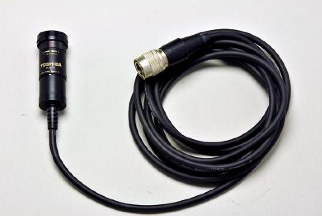

TOSHIBA IK-M10A - 1986. World's
first miniature single-chip color video camera (16.5mm diameter).
1986